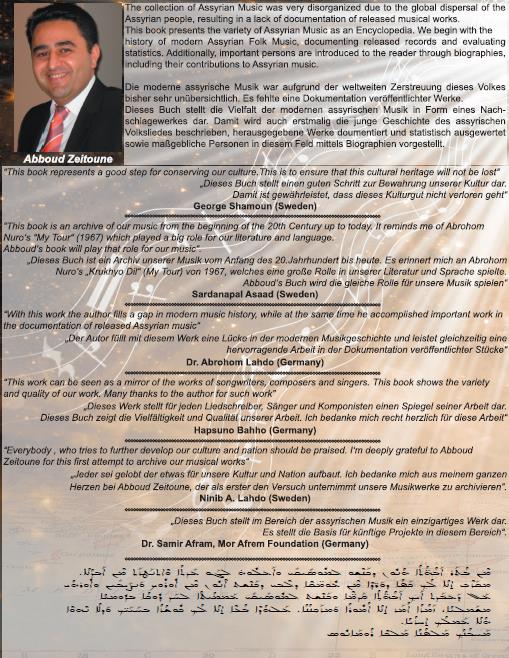Abboud Zeitoune finds “Assyrian Pearls”
in Diglat and Furat Rivers
by Helen Talia - Chicago/USA
The astounding sound of music is the heartbeat in every facet of life. Just like spring brings hope and promises that no winter can keep, music creates “stillness” in a moment, and “passion” for lovers. It turns our “silence” into a dance with God.
Introduction
Already well known for his charismatic personality and national activism in his hometown of Wiesbaden, Abboud Zeitoune entered the Assyrian consciousness with his book, “Music Pearls of Beth-Nahrin,” a clever research and sequential presentation of modern Assyrian music.
The Book
It is not hard to imagine what Abboud Zeitoune was thinking when he endeavored to compile a book about the music of a nation which remains stateless, yet its language and culture continue to have a heartbeat, mainly due to resistance, however scattered its people may be. It is a “timely” book that gives hope to the Assyrians as they continue to face some of the harshest waves of uncertainties in the Middle-East. In “The Pearls,” all Assyrian dialects are united, from Iraq, Syria, Lebanon, Turkey and Iran to the Americas, Europe and Australia.
The book, published in three languages ~ English, German and Syriac (Western dialect), contains a tactful introduction and six sections ~ modern Assyrian music history, modern Assyrian music database and statistics, Assyrian music records, children albums, church hymns and Assyrians music books. The author traces music back to pre-Christianity Sumer, Babylon and Ashur, later preserved through Christian church hymns. It offers consistent biographies, vinyl covers, and a clear timeline of modern Assyrian music. It is
the sum of all Assyrian music parts captured in a single breath, making the book an almanac.
During his research, the author met many challenges, from displaced material to unavailable and disorganized work of artists themselves, mainly due to a dispersed people. The challenge then became how to collect misplaced information from a people with no particular genealogy database and very little historical statistics, with much of its art and music lost to history. As he began his research, he became more surprised each time it grew to include more material. Finally, his work had to branch out to accompany other musical enthusiasts worldwide, who came to his assistance in this solemn project.
For generations to come, when the Assyrian culture will have exhausted in the Western
continents and only fragments of it will remain, the “Pearls of Beth-Nahrin” will become a sought after documentary because of its preservation of historical facts about a globally divided nation who persevered through its art, for as long as it could, despite its seed being sown in a foreign soil.
Author
Abboud Zeitoune was born in the ancient city of Qamishli, Syria, and educated in Lebanon and Germany, majoring in Economics. So what is an Economics major doing in music café’? Simple! Music as an art has been the “yeast” of our cultural survival, be it a church hymn, a song in a wedding, or a tune to our endless “Shaikhani” line dance that has stretched for generations.
Review
Is Everything Pearl? “Yes,” declares the author, simply because of the invaluable Assyrian language in which these artists have contributed their talents to preserve the modern Assyrian sound. This proves that we are survivors, and that no borders “tikhoubeh, Assyrian” will keep us from reaching our brethren in other countries.
Final Thoughts
Finally, something enlightening about modern Assyria! An important part of our history, that is neither political, nor draining, written by one of our own.
An unbiased book, containing the work of artists in every Assyrian dialect. This book is a hand-down from one generation to the other. The author’s plans for a runner-up volume to follow. Chebo!
~ Helen Talia
Chicago
June 16, 2008






